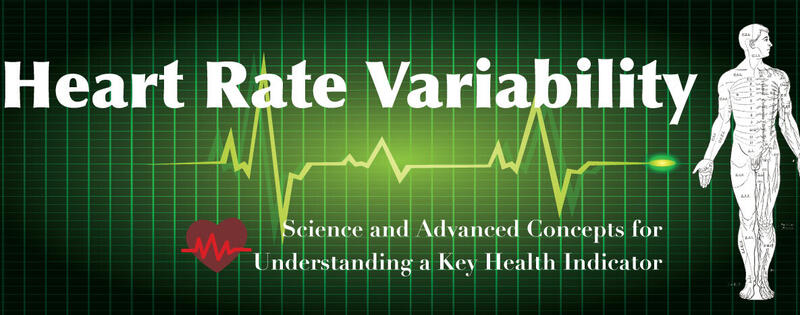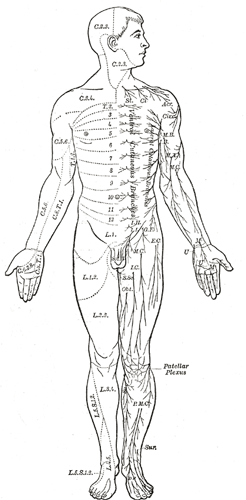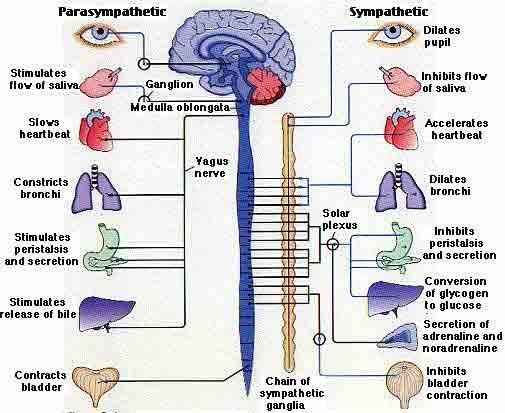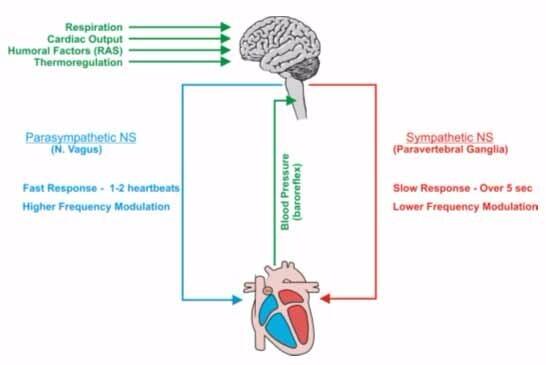
Ever wondered how stressed you are? Heart Rate Variability (HRV) is one practical way to objectively quantify your stress and health. While some amount of stress can be good, being in a constant, long-term state of stress can be very bad for our bodies and minds. HRV helps you objectively understand the state of your body and what factors trigger a stress response in you.
As a long-time biohacker and self-tracker, HRV has become one of my favorite biomarkers to track. It allows me to understand my overall state of stress on a day-to-day scale as well as contextualize what’s affecting my stress. It’s even something I can improve.
Quite simply: By measuring your HRV and capturing contextual factors like sleep, exercise, lifestyle stress, drinking, etc. you can understand your physiological stress.
What is Heart Rate Variability? Unlike Heart Rate (HR), which is the average number of beats of your heart in a minute, HRV is measuring the variance of intervals between heart beats. You can then use your calculated HRV to know if your heart rate is showing higher or lower variability in the moment and in comparison to your baseline average (typically last 7 days). Somewhat counterintuitively, lower variability is a sign of an increase in stress and activation of your sympathetic nervous system, and higher variability is a sign of being a state of rest and activation of your parasympathetic nervous system.
Your body is a complex system, and it deploys a number of systems to keep you alive and responds to its environment and internal states. Its goal is homeostasis or a kind of living balance. In order to maintain homeostasis and stay alive, your body responds to different situations through its different cells, organs, and organ systems. One of the most important is your nervous system, which transmits to different parts of the body to control actions.
In terms of the science that backs up HRV as a valuable biomarker it all comes down to how HRV acts as a proxy to a subset of your nervous system called Automatic Nervous System (ANS) and its two main branches, the Sympathetic Nervous System (SNS) and Parasympathetic Nervous System (PSNS). In order to better understand HRV and how stress works, we need to understand how HRV relates to your ANS.
In this post, which is a continuation of a previous post on HRV as a biomarker and how to track your HRV, we will be looking at Heart Rate Variability from a more scientific angle. Specifically, in order to understand our HRV scores and what factors affect our HRV, we need to understand how our nervous system acts through these two different subsystems. One of the main reasons HRV is such a key health indicator or biomarker is its ability non-invasively to tell us about the state of our automatic nervous system. For example, are we in a state of so-called “rest and digest” or in a mode of “fight or flight”?
Let’s dig in.
The Science Behind Your Automatic Nervous System

How does Heart Rate Variability relate to our bodily systems? What’s the science behind all this? We need to understand the automatic nervous system in order to understand HRV scientifically.
The autonomic nervous system (ANS) is a division of the overall nervous system called the peripheral nervous system (PNS). The PNS is the part of your nervous system that connects your brain or central nervous system with the rest of the nervous system. The PNS is your main conduit between the brain the body.
As the name implies, your automatic nervous system is largely unconscious. It controls smooth muscles and glands, and influences the function of internal organs. For example, ANS regulates heart rate, digestion, respiratory rate, pupillary response, urination, and sexual arousal.
The ANS is also the mechanism handling our fight-or-flight or acute stress response. In certain situations, ANS switches into an alert state, also known as the sympathetic. Our digestion and other non-essential systems are de-priorized include decrease in metabolism and oxygen in certain areas, and our heart rate increases and muscles prepare for action in other areas.
The autonomic nervous system is made up of two complementary branches: the sympathetic nervous system (SNS) and the parasympathetic nervous system (PSNS).
“Wiring” Your Two Automatic Nervous Systems and Its Response Mechanisms

Source: Heart Rate Variability Basics
Without going too deep into the anatomy and physiology, it is worth noting that the sympathetic and parasympathetic systems originate in different parts of the body and have separate nervous pathways they employ to trigger their specific responses.
The Sympathetic originates in thoracolumbar region, meaning between you thoracic and lumbar vertebrae of your spinal cord. The parasympathetic are craniosacral, meaning they sprout from base of your brain and just superior to your tailbone.
In terms of their main functions:
The sympathetic nervous system is often considered the “fight or flight” system, while the parasympathetic nervous system is often considered the “rest and digest” or “feed and breed” system. In many cases, both of these systems have “opposite” actions where one system activates a physiological response and the other inhibits it. (Source: Wikipedia)
While there are a number of exceptions and these definitions might be considered an oversimplification, the key idea is this: “the sympathetic nervous system is a ‘quick response mobilizing system’ and the parasympathetic is a ‘more slowly activated dampening system’.”
Or to put it another way, your sympathetic nervous system (SNS) is the call to action of the fight-or-flight response. When needed, SNS floods your system with energy, dilates pupils, slows digestion and increases heart rate. While initially a nervous response, SNS triggers hormonal responses all across the body.
By contrast, your parasympathetic nervous system (PSNS) is your rest and repair response. It is designed for long-term needs. When triggered, PSNS conserves energy, constricts pupils, aids digestion, and slows heart rate. This is the system that helps your grow stronger, faster and healthier.
Let’s look at how HRV relates to this.
HRV and the Two Sides of the Automatic Nervous System

Heart Rate Variability “taps” directly in your automatic nervous system. Your heart is not a computer or metronome. In fact, your heart rate is “erratic” or, to put in scientific terms, it shows variance.
This variability is the push and pull of your nervous system. Your body is saying speed up or slow down according to the situation and feedback from your senses, emotions, mind, etc.
Biology is all about homeostasis or finding balance. A heathy nervous system is seeking balance between the two main divisions of the automatic nervous system, Sympathetic (SNS) or Parasympathetic (PSNS). This causes high Heart Rate Variability.
Here are a few specific examples of how HRV indicates the state of your ANS:
- A decreased PSNS activity or increased SNS activity will result in reduced HRV.
- Low variability means Sympathetic is active. Your body is stressed and is in fight-or-flight mode.
- High variability typically means higher Parasympathetic activity. Your body has low stress and is resting and digesting.
Overall, we need both periods of stress and rest, and you should aim for a balance of Sympathetic and Parasympathetic activity. This doesn’t mean stasis but rather an oscillating change over time. These are caused by different factors that affect your physiology and, by proxy, your HRV.
Your HRV and ANS: High/Low Variability Can Be Good or Bad
Somewhat counterintuitively, high HRV is generally good and low HRV is bad. You want to see variability in heart rate.
Scientifically speaking, your HRV is a correlate to your automatic nervous system. To quote from HRV4Training’s summary:
The autonomic nervous system regulates many body functions, mainly unconsciously, such as respiration, the heart beating and so on, and consists of two branches…The sympathetic branch, is in charge of the fight or flight response, while the parasympathetic branch promotes a rest and recovery.
The automatic nervous system keeps our bodily states in balance and reacts to different stressors. So, when our body is recovered and rested, we expect to see higher higher parasympathetic activity. When our body is recovering or dealing with stresses (more on this later), sympathetic activity is more noticeable.
To quote again from HRV4Training (my preferred tool for tracking my HRV),
Since the autonomic system regulates the heart beating, we can use HRV as a proxy to autonomic function, and therefore use HRV as a way to measure how we react to stressors like a workout for example.
Our nervous system acts in different ways according to the state it is in. Using HRV we can gauge what state our body is in and, using context, we can tailor our lifestyle, training, or recovery choices.
To break this down one more level, our body’s heart rate variability worsens (gets lower) when we are reacting to different stressors. When we are stressed following a sickness, hard training or other factors, the sympathetic system is more active.
When we are rested, our heart rate variability is higher and points towards a bodily state, including the heart and nervous system, that is more flexible and ready to respond to increased stressors and loads.
Overall, low HRV or variability is more negative and higher variability is good, but the context is important. If you had a long day of travel or just completed a long, intense run, it’s not surprising to see your HRV worsen.
Since without context (like previous day’s training or behaviors), it’s impossible to know how to interpret the signal your HRV reading is giving you. This is one of the challenges with simply passively monitoring your HRV; you have no context to understand it in.
What Your HRV Scores Tell You In View of Your Automatic Nervous System
While we are mostly focused on measuring HRV for “morning readiness” and have mostly focused on chronic stressors, it’s important to remember how HRV can be highly influenced by acute stressors too. That could be any number of things from an emotional conversation, a heavy lunch or just moving about. This is generally why many believe HRV should be used in a consistent, controlled daily tracking regime than for continuous monitoring.
What can your HRV values tell you about yourself?
Leading Causes of Death Show Changes in HRV
According to multiple studies, changes in HRV have been correlated with 9 out of the 10 leading causes of death in the United States. That means that HRV can provide an additional clue in understanding if you have a disease or at risk of death. More research needs to be done to tease out the relationship between HRV and sickness, but in view of how disease, sickness and injury all activate your sympathetic nervous system, it’s not surprising that decreased HRV is a sign of a stressed out body.
Quite simply: Heart Rate Variability can and does significantly decline with decreased health.
Increased Fitness Associated with Higher HRV
On the more positive side, higher heart rate variability has been correlated with increased fitness, health, and even youthfulness. That means that activities like exercise and mindfulness meditation, which are used as tools and techniques to improve your HRV, are also ameliorate your fitness too. For example, an active lifestyle can significantly increase HRV over a sedentary lifestyle.
According to researchers, one likely explanation of significantly greater Heart Rate Variability in trained men and women at rest is due to increased vagal tone and parasympathetic activity and reduced sympathetic activity.
While not definitive, this potentially creates a positive feedback loop between understanding and improving your HRV and understanding and improving your fitness.
Your Biological Age?: HRV as an Indicator of Your Homeostatic Capacity
One of the most important roles of human physiology is maintaining homeostasis. Basically we aim to maintain stability, and we do this via our homeostatic capacity, which “refers to the capability of systems to self-stabilize in response to external forces or stressors, or more simply the capability of systems to maintain homeostasis.” (Wikipedia)
Natural selection has shaped a “hierarchy and network of traits” that helps keep us alive and respond to stimuli, both internal and external, and we do this through our homeostatic capacity. Our ability to respond well and maintain homeostasis effectively is one key indicator of our biological age.
Unfortunately, like our HRV, our homeostatic capacity naturally declines with age. As more effort in Silicon Valley and around the world is put into increasing human longevity, it is important to have biomarkers that help indicate heath and age. One popular example is telomere length in our DNA. HRV is also one way to understand our biological age since it correlates heavily with homeostatic capacity or how well we respond to stressors.
Simply put a higher heart rate variability might also indicate a lower biological age or youthfulness.
Factors That Influence Your HRV
In Heart Rate Variability: The Amazing Biomarker to Understanding Our Body, Health and Fitness , we looked at how HRV is measured scientifically and some tools and apps you can use to capture your own HRV. We also explored some of the factors that affect our HRV.
Research has found four broad categories of things that influence our HRV: Non-influencable physiological factors (age, gender, genetics), Diseases, External factors (medications, noise, pollution) and Influenceable lifestyle factors.
This last category of lifestyle factors include physical fitness, increased body weight, smoking and alcohol abuse. Through my own self-tracking, I’ve been able to notice correlations in some of these areas in my own life.
In short, research shows and my own numbers indicate correlations between HRV scores and factors like training (and overtraining), physical fitness level, smoking, drinking, lifestyle stress, and obesity among many others.
Conclusion: Heart Rate Variability a Non-Invasive Indicator of Your Stress, Nervous System and
Your body is a complex organism. Human anatomy and physiology reveal all the amazing ways we deploy different systems to stay in homeostasis or the balanced state of staying alive. From biochemical and hormonal feedback loops to specialized organ systems, our bodies do some pretty impressive stuff. One key system in your body is the nervous system, which regulates a host of systems in response to stimuli. One way to understand the state of your nervous system and to to gain a real-time sense of what is happening there is by measuring heart rate variability.
In this post, we looked what is your automatic nervous system (ANS) and the relationship between its two main branches, the Sympathetic Nervous System (SNS) and Parasympathetic Nervous System (PSNS). Each of the systems are deployed as mechanisms to maintain an optimal biological state, and HRV acts as a proxy to what’s going in those two main branches.
In the case of the sympathetic, it responds to internal and external stressors by increasing heart rate, deemphasizing non-essential organ systems like digestion and activating certain muscles groups and hormones. When you are in a sympathetic state, you are stressed or “fight or flight” mode. By contrast, a parasympathetic state is your rest and recovery state where your body’s heart rate is normal, and you are focused on digesting and recovery. When you are in a parasympathetic state, you are not stressed and in a “rest and digest” mode.
Your Heart Rate Variability (HRV), which in contrast to Heart Rate that measures your average number of beats per minute, measures the variance of intervals between heart beats. This variance can be used to know which automatic nervous system is currently most active. HRV acts as a proxy to your ANS. HRV is telling you if your body’s current primary mode is sympathetic (fight or flight) or parasympathetic (rest and digest). HRV acts as a proxy to your ANS.
Human anatomy and physiology contain a sophisticated and complex balance of processes. We operate through multiple systems and signaling pathways. Some of them are hormonal and biochemical, and we can use blood test tracking to know more about those. Others are nervous, and HRV is a way to track your nervous state. Like Blood Pressure Tracking, HRV is a vital sign you can measure non-invasively. This makes it a high significant while also easy to track yourself.
While a broad scientific understanding of how we work as human is well-established, it’s only recently that we’ve had the technology to measure our bodies in such an interesting way. For me, I’ve used HRV as way to gauge how much stress I’ve accumulated, how well I’m adapting to hard run training, and probably most importantly how health, young and well I am.
How do you track your biology? Do you use HRV or other methods? And what have you learned?
